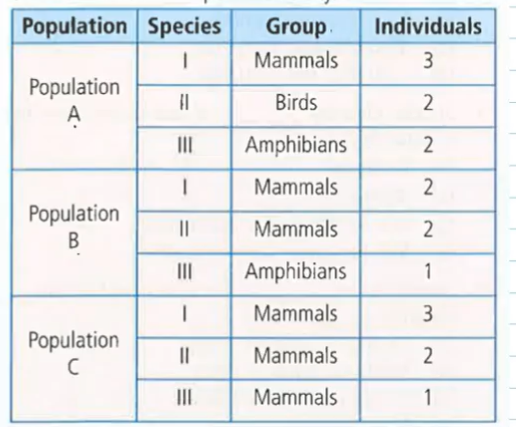If a biologist is to nomenclate a similar species, he will study
syntype
isotype
Neotype
paratype
The correct Answer is:B
To answer the question "If a biologist is to nomenclate a similar species, he will study," we need to understand the different types of specimens used in biological nomenclature. Here’s a step-by-step breakdown:
Step 1: Understand the Context of Nomenclature
Nomenclature in biology refers to the system of naming organisms. A biologist, or taxonomist, must refer to specific specimens to ensure that the names assigned to species are accurate and consistent.
Hint: Nomenclature is crucial for identifying and classifying organisms correctly.
Step 2: Identify the Types of Specimens
The main types of specimens mentioned are:
- Holotype: The single specimen designated as the type for a species.
- Isotype: Duplicates of the holotype, distributed to various institutions.
- Syntype: Specimens cited by the author when the holotype is lost.
- Neotype: A specimen selected to serve as the type when the holotype is lost.
- Paratype: Specimens that help define the species but are not the holotype.
Hint: Each type of specimen serves a specific role in the classification process.
Step 3: Determine the Most Relevant Specimen for Nomenclature
For a biologist to nomenclate a similar species, they would primarily study the isotype. This is because isotypes are duplicates of the holotype and are used to ensure that the naming is consistent across different specimens.
Hint: Isotypes are essential for confirming the identity of a species when the holotype is not available for study.
Step 4: Eliminate Incorrect Options
- Syntype and Neotype are used when the holotype is lost, which is not the case here.
- Paratype helps define the species but is not the primary specimen for nomenclature.
Hint: Focus on the specimen that is directly associated with the naming process.
Conclusion
The correct answer to the question is that if a biologist is to nomenclate a similar species, he will study an isotype.
Final Answer: Isotype (Option B)
Nomenclature in biology refers to the system of naming organisms. A biologist, or taxonomist, must refer to specific specimens to ensure that the names assigned to species are accurate and consistent.
The main types of specimens mentioned are:
- Holotype: The single specimen designated as the type for a species.
- Isotype: Duplicates of the holotype, distributed to various institutions.
- Syntype: Specimens cited by the author when the holotype is lost.
- Neotype: A specimen selected to serve as the type when the holotype is lost.
- Paratype: Specimens that help define the species but are not the holotype.
For a biologist to nomenclate a similar species, they would primarily study the isotype. This is because isotypes are duplicates of the holotype and are used to ensure that the naming is consistent across different specimens.
- Syntype and Neotype are used when the holotype is lost, which is not the case here.
- Paratype helps define the species but is not the primary specimen for nomenclature.
The correct answer to the question is that if a biologist is to nomenclate a similar species, he will study an isotype.
Topper's Solved these Questions
Similar Questions
Knowledge Check
A certain type of grass has a diploid chromosome number of 8. A similar species of grass has a diploid chromosome number of 10. Interspecific hybridisation between the two species results in sterile hybrids that can, nonetheles, reproduce vegetatively. The diploid chromosome number of these hybrids would be
A9B16C18D20Study the given populations and choose the correct answer in relation to species diversity.
 AMaximum diversityMinimum diversityPopulation BPopulation CBMaximum diversityMinimum diversityPopulation APopulation CCMaximum diversityMinimum diversityPopulation APopulation BDMaximum diversityMinimum diversityPopulation BPopulation A
AMaximum diversityMinimum diversityPopulation BPopulation CBMaximum diversityMinimum diversityPopulation APopulation CCMaximum diversityMinimum diversityPopulation APopulation BDMaximum diversityMinimum diversityPopulation BPopulation AAssertion : Species is a group of individuals with fundamental similarities.
Reason : Indica, leo tuberosum represent such group of individuals.AIf both assertion and reason are true and reason is the correct explanation of assertion.BIf both assertion and reason are true but reason is not correct explanation of assertion.CIf assertion is true but reason is false.DIf both assertion and reason are false.
read the statements w.r.t species. (a) on the basis of taxonomic studies, species is the group of individuals with fundamental similarities. (b) each species have distinct morphological characters than other species. (c) species are group of organisms capable of interbreeding and producing fertile offspring. (d) all species with similarities in morphological features are kept in the same genus and assign to same species epithet
View SolutionLife to a biologist is essentially physico-chemical.
View SolutionWhy is it so difficult for biologists to agree on a classification of protists?
View SolutionTaxonomic studies consider a group of individuals organisms with fundamental similarities as a
View SolutionBoth a wine maker and a molecular biologist who had developed a recombinant vaccine claim to be biotechnologists. Who in your opinion is correct?
View Solution
